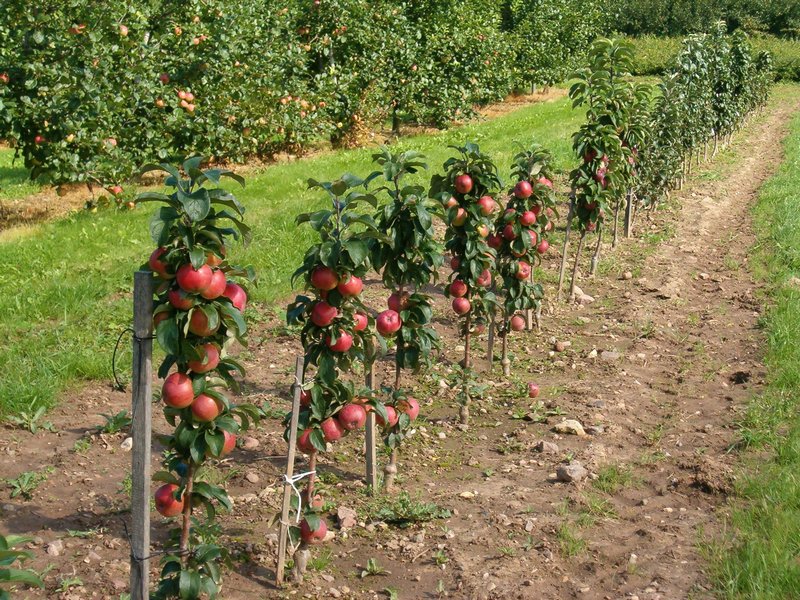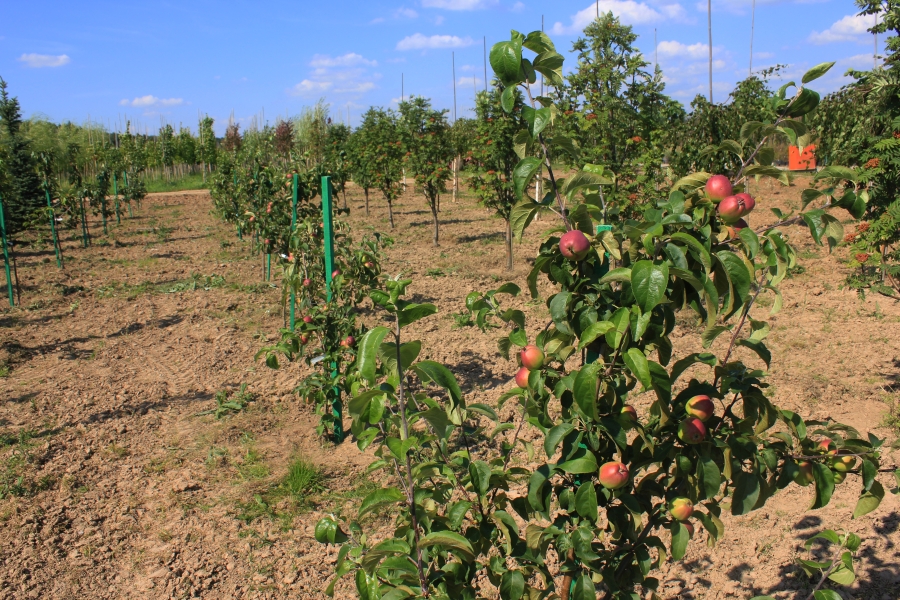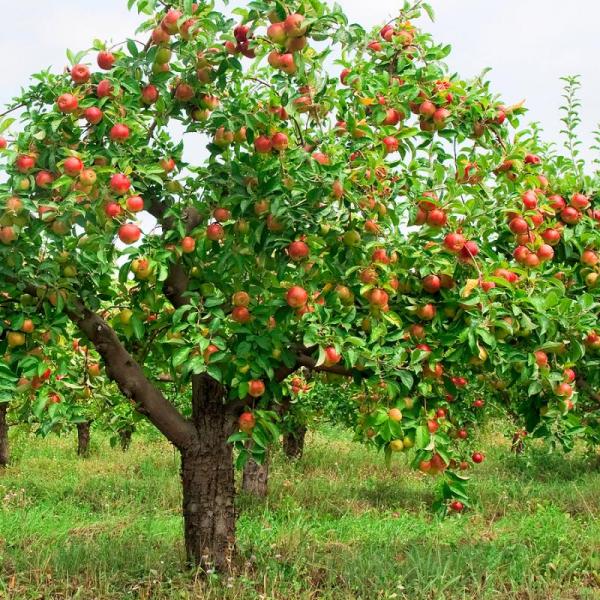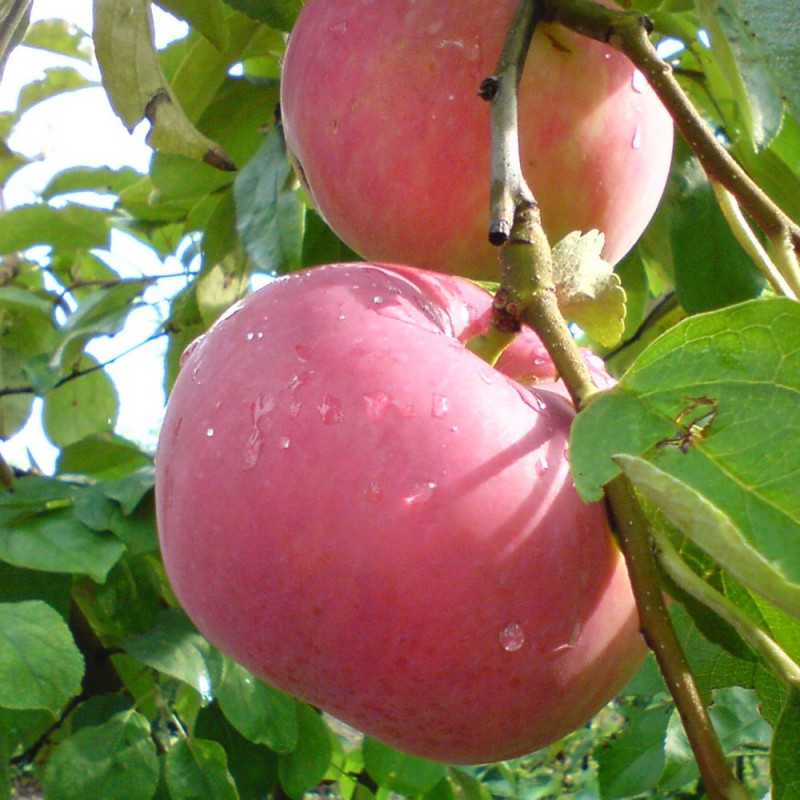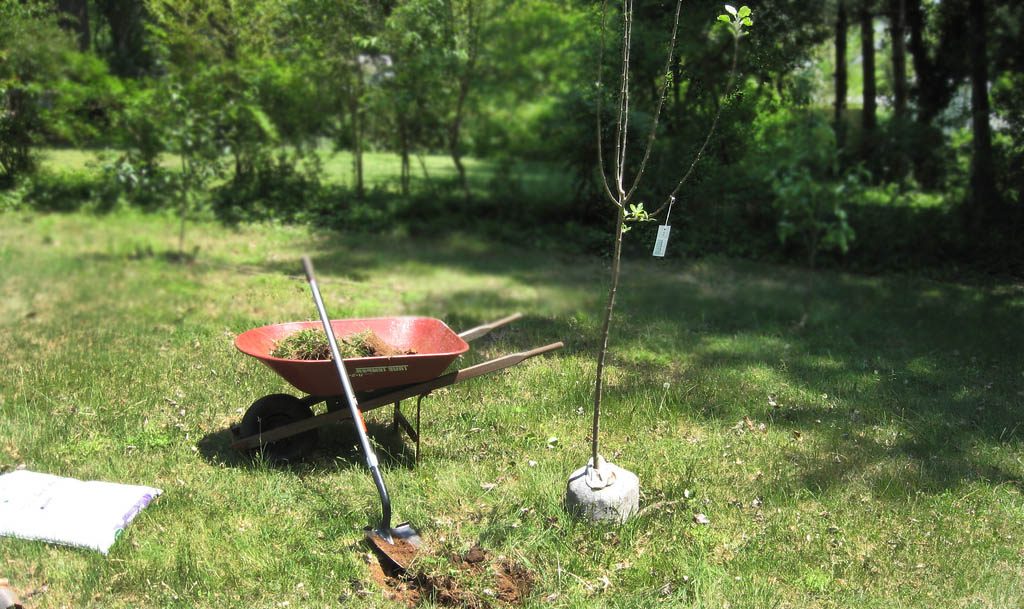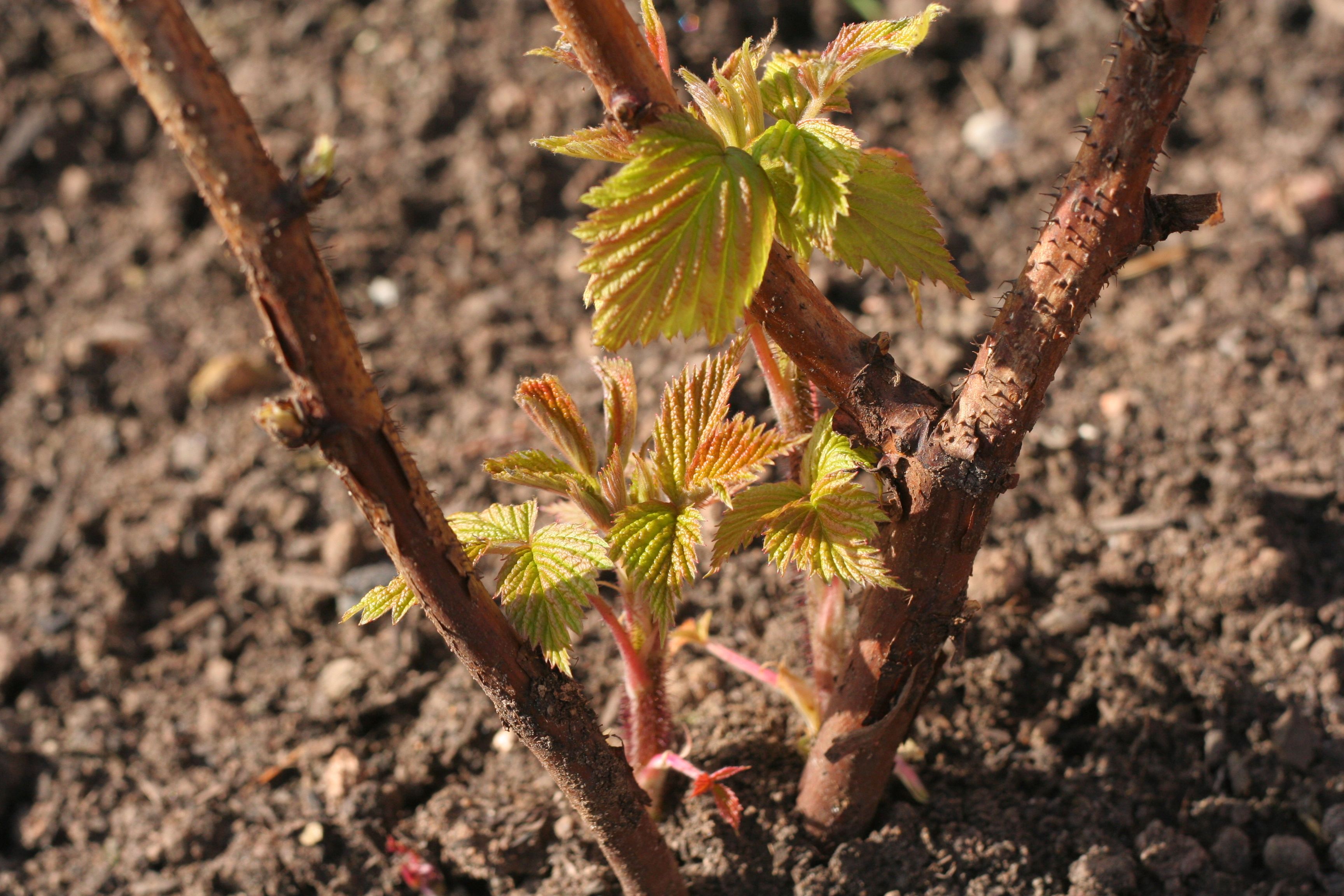Content:
Its further growth and development depends on the correct planting of a young apple tree. In this matter, every little thing is important: the right choice of place, soil preparation, the quality of the seedling itself. Planting features also depend on whether the tree will be with a closed or open root system. And of course, further care plays a role.
Criteria for choosing an apple seedling for spring planting
First of all, you need to remember that planting apple trees in spring with seedlings should begin with choosing a nursery where they can offer high-quality material. After all, if you buy a seedling from an unscrupulous seller, after a few years the summer resident may find that he managed to grow something completely different from what he wanted. In addition, an accidental purchase can result in the tree being unvaccinated, sick or with dry roots.
In a specialized nursery, the gardener will not only be sold the desired variety, you can also be sure that the seedling is properly grafted and passed the control of the sanitary service. During the season, nurseries take out planting material for sale to the markets, in this case the seller must have a corresponding certificate, which he is ready to provide upon request.
When the gardener decided on the apple variety and chose a nursery for its purchase, it was the turn for selection according to other criteria.
Groundwater level
If the garden is located on an area with a low groundwater table (below 3 m), the stock can be of any type - vigorous, semi-dwarf, dwarf. When the groundwater is high, you should not buy seedlings on a seed (vigorous) rootstock. Such a tree will grow too tall, with a powerful root system that will reach the water. As a result, the apple tree will become weakened and start to hurt, and in winter it can freeze out. The crown of such a tree, as a rule, is prone to wilting, and you can not count on a large harvest.
With a close occurrence of groundwater (above 1.5 m), only seedlings on a dwarf rootstock or columnar varieties of apple trees with a superficial root system are suitable for the site. Of course, columnar apple trees are less frost-resistant and do not give such plentiful harvests, but a rather dense planting is acceptable for them. Saving space on the site will be significant.
Terms of fruiting
When choosing an apple tree according to the fruiting period, you need to take into account the weather of the region where it will be planted. If you plant an autumn variety in the northern region, the fruits simply will not have time to ripen before the onset of cold weather. To nothing in Siberia and the resistance of the apple tree to diseases that develop in hot climates. In a warm area, the tree does not need increased frost resistance at all. All apple trees are divided into three types according to the ripening period:
- Summer. The harvest from these apple trees is harvested in August and it is stored for no more than a month. These varieties have excellent taste. These varieties are usually grown in the north.Medunitsa, Grushovka and White filling are suitable for planting in the middle lane.
- Autumn. In these apple trees, fruiting occurs in September and the fruits can be kept fresh for another month. Typical representatives are Cinnamon striped, Borovinka and Melba.
- Winter. These apple trees continue to bear fruit until October and have the longest shelf life (up to 6 months). The varieties belonging to this group are suitable for planting in the southern regions, where there are hot summers and warm autumn. Bogatyr, Antonovka, Aport, Welsey, Ranetka are very popular. Winter apples have firm pulp and excellent taste.
In addition, when buying, you need to pay attention to the condition of the seedling itself. Its roots should not be sluggish and dry. Their deplorable state speaks of improper storage, which in the future will lead to poor survival. On the cut, the roots should be white, this will indicate that they are alive. The root system should be branched and about 30 cm long.
The stem is supposed to be strong and even, without damage. An unvaccinated tree can be recognized by the perpendicular arrangement of the branches relative to the trunk and the thorns on them. Seeing this, we can say with confidence that this is a wild one. It is not worth purchasing such a seedling.
Planting an apple tree in spring with seedlings with a closed root system
When choosing a seedling, a lover of agriculture and gardening should give preference to a tree with a closed root system. The advantage of such apple trees is that their roots are better preserved during storage and do not suffer during transplantation. Such a seedling will take root equally well in spring, summer and autumn. The landing procedure will look like this:
- For the most popular medium-sized apple trees, a planting pit is prepared with a depth of 50 cm and a diameter of 1 m.If several trees are to be planted, an interval of 3-4 m is required between them.The distance between rows should be at least 5 m.
- The infertile soil layer is removed and the bottom of the pit is filled with a mixture of soil, compost and ash. Additionally, you can add 1-2 handfuls of mineral fertilizers.
- In the nutrient mixture, make a depression equal to the diameter of the pot and spill the earth with water. Before planting, they also water the apple tree in the pot.
- The planting container is turned upside down and, holding the tree trunk with one hand, with the other, carefully remove the pot with twisting movements, trying not to violate the integrity of the earthen coma.
- After that, the seedling is installed in such a way that the level of the ground in which the apple tree grew is flush with the upper edge of the planting pit or slightly higher. Only with such a planting will the root collar be positioned correctly.
- A peg is placed next to the earthen clod for a garter of seedlings, making sure that it does not damage the roots.
- Next, fill the space remaining in the pit on the sides of the seedling with earth, periodically moistening the earth in the process so that it becomes denser.
- After planting, the soil should be tamped a little around the circumference, without pressing on the earthen lump in which the seedling was sitting. As a result, a small depression should form around the apple tree.
- Up to 2 buckets of water are carefully poured into the resulting groove in several steps.
Now you need to mulch the soil with a layer of fertile soil and tie the seedling to a peg. It will be possible to remove the support in 2 years, when the apple tree gets stronger.
How to plant an apple tree seedling in spring with an open root system
Planting apple seedlings with an open root system can be done in autumn or spring. In springtime, this should be done before the buds swell. Planting a seedling step by step will look like this:
- It is necessary to prepare a planting hole with a size corresponding to the volume of the roots. The older the seedling, the wider and deeper the hole will be.
- The bottom layer of the earth should be removed, and the top fertile soil should be mixed with humus and phosphorus-potassium fertilizers. The well will be filled with this mixture.
- At the bottom of the pit, a mound is made from fertilized soil, after which a support for an apple tree of a suitable size is driven in.
- The skeletal roots of the seedling are cut off and dipped in a clay mash with the addition of root. The branches before planting are shortened by half or 1/3 of the length.
- The seedling is placed on a mound and the roots are spread so that they are evenly distributed.
- In the process of planting, the earth is added in layers, lightly tamping each of them and pouring a bucket of water. This is done until the pit is completely filled.
- It is important not to let the seedling sink into the soil. After planting, the root collar should remain at the level of the edge of the hole.
- After planting, the ground is tamped so that there are no voids left inside, and a small groove is dug around.
- After planting, the tree is watered through the dug hole and tied to a peg.
It is more convenient to plant an apple tree together. One person will hold the tree in the desired position, and the other will work with a shovel.
Tips from experienced gardeners for further care
A young apple tree needs to be provided with comprehensive care if the gardener wants to have good yields in the future.
Watering
The apple trees planted in the current season are watered for the first time 2 weeks after planting. The second watering is carried out in a month, and the third - during the period of leaf fall. The amount of moisture introduced depends on the weather conditions. Usually this is 4-6 buckets per tree. In this case, it is necessary to take into account the presence or absence of rain, the composition of the soil.
In subsequent seasons, apple trees are watered on a slightly different schedule:
- the first watering is carried out on the eve of flowering;
- the second time the earth is moistened when excess ovaries crumble;
- for the third time, watering is carried out during the period of fruit filling;
- the fourth watering is carried out after leaf fall.
On medium-density soils, 50-60 liters of water is poured under a tree at a time, in clay soil the volume of moisture is reduced by 15-20%, and on sandy loam or peat soil, on the contrary, it is increased by 20%. During a drought period, the apple tree is additionally moistened by watering twice a month.
Top dressing
In order for a young tree to quickly build up its vegetative mass, the first 2 years it is fertilized in early spring. For the first time, you can feed the apple tree with mullein infusion. It is also permissible to use compost or humus as a source of nitrogen (1 bucket).
In May and June, it is recommended to carry out foliar dressing with mineral fertilizers for fruit trees. For grown apple trees, autumn feeding with phosphorus and potassium salts is also recommended. Fertilizer is scattered in the trunk circle and dug up.
If we are talking about an apple tree just beginning to bear fruit, urea feeding will be useful for it. The same fertilizer can be applied in those years when weak flowering is observed. 35 g of fertilizer are dissolved in 10 liters of water and sprayed with foliage. It is recommended to carry out the treatment twice: immediately after the petals fall and after a month.
Mulching
Mulching the apple tree trunk circle reduces the fluctuations in soil temperature near the suction roots, supplies the soil with humus, reduces water evaporation, helps to increase beneficial soil bacteria, and prevents a dense crust from forming on the surface of the earth after moistening.
Low-lying peat, compost, rotted manure, hulls from seeds are perfect as mulch. The use of needles, spruce and pine sawdust, high peat, straw and chaff is unacceptable, as these materials contribute to an increase in soil acidity.
Protection against diseases and pests
Chemicals are used only for control, but not for prevention.This is due to their harmful effects on beneficial insects. As a prophylaxis of diseases and pests, it is necessary to remove and burn fallen leaves and dry apples in a timely manner. Treatment of branches with a solution of soda ash will help from spores of fungi and bark beetle.
As soon as young leaves appear, the apple tree can be treated with Bordeaux liquid. The appeared mite is destroyed with actellik, the flower beetle - with actara, gnawing and sucking parasites - with entobacterin or dendrobacillin. After flowering, in order not to apply "chemistry", it is recommended to install trapping belts on the tree. In wet weather, the prevention of fungal diseases is carried out by treatment with phytosporin.
Pruning
In the first year after planting, pruning gives the young apple tree the correct crown shape. Weak and broken shoots are cut out completely. The branches thickening the crown are shortened by 2/3. Tops and unnecessary growths, branches that cross each other are removed. The procedure should be carried out before flowering begins.
Proper spring planting of apple seedlings should be given the utmost attention. It is the key to the active growth of the tree and subsequent rich harvests.
